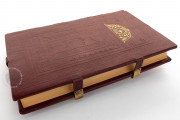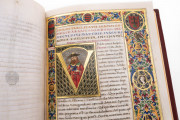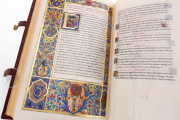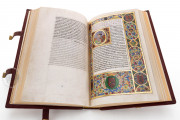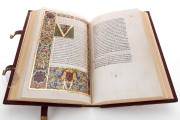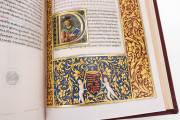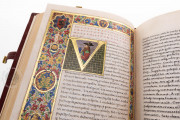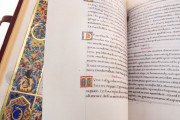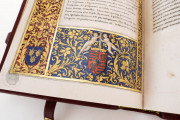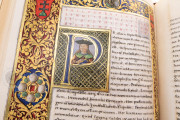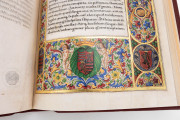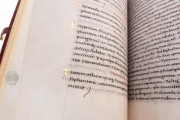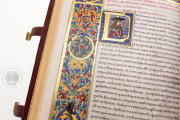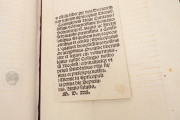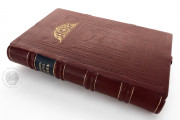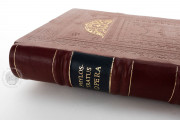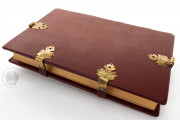King Matthias Corvinus (23 February 1443 – 6 April 1490) was one of the most powerful renaissance rulers of Europe, he was King of Hungary and Croatia. Educated in Italian and a great admirer of italian renaissance art, he collected a library consisting of about 3000 volumes called the Bibliotheca Corviniana.
The Works of Philostratus manuscript is a piece of this collection, which contains the works of the sophist Philostratus of Athens and of his nephew (3rd c. AD.) In the book we find the curriculum vitae of antic heroes and philosophers, letters and the description of an art collection in Naples.
This codex is one of the most finely decorated codices of the Corvina Library. Its importance is unique: the translation, dedication, the splendid manuscript itself, from the first letter till the last brush stroke was created for King Matthias.
The court historian Antonio Bonfini translated the work of the Athenian Sophist Philostratos (3rd century AD) and his nephew, from Greek into Latin in the spring of 1487. The illustrations were made in Florence, in the workshop of Boccardino il Vecchio. The manuscript reached Buda from Florence in Matthias’ lifetime, but the leather binding with architectonic ornamentation bears the arms of his successor, Wladislas II.
All of the carefully arranged dominantly red and gilded and blue and gilded diptich-like double title page is covered in finely elaborated miniatures: even the margins of pages, usually kept white, are painted in yellowish green with lace-like gilding. On the left-hand side you can read the contents index of the codex in the form of a monumental inscription: the gilded bronze sheet with embossed letters is in the frame of a white stone niche. On the pedestal of the building there is the imitation of an antique relief depicting a fight of sea gods. On the left, King Matthias’s antique-like medal portrait appears surrounded by white putti and hanging arms, having the portraits of Nero and Hadrian, the two Roman emperors especially predisposed to Greek culture, on his two sides. (The caption running around in the medal calls Matthias the king of Hungary and Bohemia, and the prince of Austria.) In the middle of the other side, there is the imitation of an oval bronze relief, showing Apollon, Olympos and Marsyas, modelled on a famous antique karneol-intaglio in Lorenzo de’ Medici’s art collection.
In the initial of the page on the right-hand side there is a triumphant procession. The tiny crowned figure on the chariot has been identified, among others, as Matthias, while in other cases as his son János Corvin. The Prologue actually describes the triumph celebrating the conquest of Wiener Neustadt. Both pages have Matthias’s coat of arms at their bottom (in the one on the right the shield also features Austria’s silver-swathed crest against a red background).The ornaments on the margins feature the royal emblems (a beehive, a barrel, an hour-glass, a dragon and a well).
The codex has six more full-page decorative sheets (ff. 11r, 64r, 84v, 109v, 137r, 166v).
In 1513, the Works of Philostratus manuscript was bought from Wladislas II by the Viennese humanist Johannes Gremper, then finding its way to Johannes Cuspinianus, and later to Johannes Fabri. In the framework of the Venice Agreement in 1932 it was transferred from the Österreichische Nationalbibliothek into the National Széchényi Library.
Binding description
Leather binding with architectonic ornamentation bearing the arms of Wladislas II, king of Bohemia and king of Hungary and Croatia after the Matthias Corvinus' death (1490-1516).
We have 1 facsimile edition of the manuscript "Works of Philostratus": Philostratus Flavius: Opera facsimile edition, published by Pytheas Books
Request Info / Price

